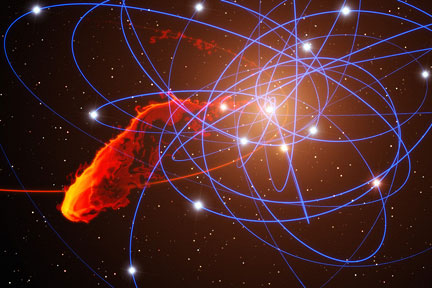The supermassive black hole at the
center of our galaxy is about to consume a tasty morsel. Astronomers are
salivating as they prepare to witness a cosmic feast that may last
several years.
Supermassive black holes have been found
at the centers of most major galaxies; some are 10 billion times more
massive than our Sun. Our own galaxy, the Milky Way, has a much more
modest central black hole, Sagittarius A* (pronounced “A star”). Sag A*,
as its friends call it, is a mere pipsqueak by comparison, “only” 4 million times more massive than our Sun.
Black holes increase their mass by
sucking in surrounding matter — stars, gas clouds, and the odd planet.
It seems that Sag A* has been a very picky eater, consuming thousands of
times less matter than the central black holes of other galaxies, and
therefore emitting thousands of times less radiation. Sag A*’s modest
appetite has made our galaxy a much safer place for life.
But now, Sag A*’s dinner bell is ringing.
In December 2011, Astronomers from
Germany, the U.S. and Chile reported observations of a gas cloud coming
too close to Sag A* for comfort. Their observations were made with the
European Southern Observatory’s VLT radio telescope array. They’ve
identified a gas cloud moving toward Sag A* at 5 million miles per hour.
The cloud contains three times Earth’s mass, or only 2 trillionth’s of
Sag A*’s mass. So this will be a modest meal — equivalent to a person
eating a bonbon only 1/1000th of an inch across.
The gas cloud’s projected orbit will
take it to within 24 billion miles of Sag A* by mid- 2013. Only stars S2
and S14, (S2 at 11 billion miles and S14 at 7 billion miles), have
orbits that venture closer to Sag A*. All of these orbits lie far beyond
the 8 million mile radius of Sag A*’s event horizon (its Schwarzchild
radius and the point of no return). Created by Marc Schartmann, below is
an illustration of Sag A*’s vicinity at the Milky Way’s center — the
blue ellipses show the orbits of nearby stars and the red arc represents
the orbit of this gas cloud. The actual size of the gas cloud is much
smaller than illustrated here.

While stars can survive passing within a
few billions of miles from Sag A*, this gas cloud won’t. The reason is
that stars are far denser and have much stronger self-gravity than gas
clouds. This gas cloud’s average radius is 12 billion miles compared
with Earth’s 4000 miles and our Sun’s 400,000 miles. With its mass
spread over this great volume, the gas cloud’s self-gravity is only
one-billionth of what’s needed to resist Sag A*’s gravitational tidal
forces — the black hole will shred the gas cloud to pieces. The
color-coded image below shows the extent of the gas cloud as actually
observed from 2000 through 2011, as well as computer projections of its
demise from 2012 through 2016.

Once shredded, the gas cloud’s debris
will be dragged into the accretion disk surrounding Sag A* and
ultimately pulled within its event horizon to oblivion. Black hole
feasting has been observed in remote galaxies — this is what drives
quasars and active galactic nuclei (AGN’s). But now it will be happening
up close and personal, in our own backyard “only” 27,000 light-years
(160,000 trillion miles) away. Astronomers are eager to carefully
observe and document Sag A*’s feast. We’ll be close enough to get a good
look at the action, but far enough away not to become part of the
mayhem — our solar system is in the Goldilocks Zone of our galaxy.
Best Regards,
Robert
Note: Previous newsletters can be found on my website.
|